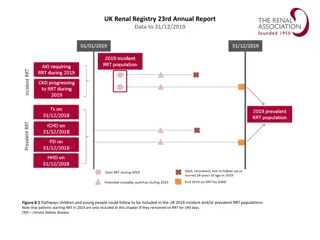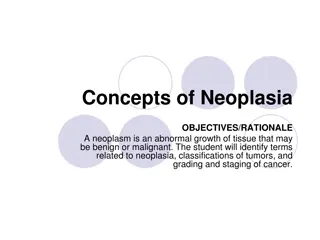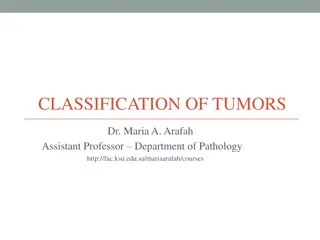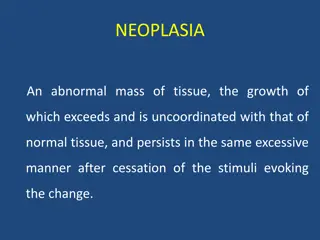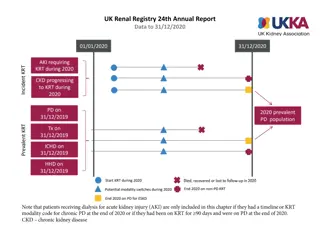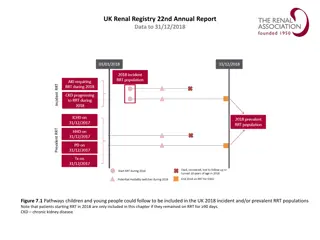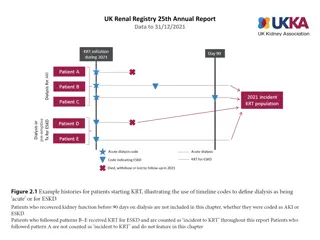Overview of Renal Tumors: Benign and Malignant Forms
Explore the spectrum of renal tumors, from benign papillary adenomas and oncocytomas to malignant renal cell carcinomas like clear cell carcinoma. Images and descriptions showcase the gross pathology and histopathology of these tumors. Learn about the features and prognosis of different renal tumor types identified by the Pathology Department at KSU Renal Block.
Download Presentation

Please find below an Image/Link to download the presentation.
The content on the website is provided AS IS for your information and personal use only. It may not be sold, licensed, or shared on other websites without obtaining consent from the author.If you encounter any issues during the download, it is possible that the publisher has removed the file from their server.
You are allowed to download the files provided on this website for personal or commercial use, subject to the condition that they are used lawfully. All files are the property of their respective owners.
The content on the website is provided AS IS for your information and personal use only. It may not be sold, licensed, or shared on other websites without obtaining consent from the author.
E N D
Presentation Transcript
RENAL TUMORS Renal Practical III Pathology Dept , KSU Renal Block
BENIGN RENAL TUMORS RARE Tumors Papillary Adenoma (SIZE very important) Fibroma/ Hamartoma Angiomyolipoma Oncocytoma Pathology Dept , KSU Renal Block
Renal Oncocytoma - Gross Renal mass with yellow mahogany colour (reddish brown color). Central scar seen in the middle of the mass. Benign tumour with excellent prognosis. Pathology Dept , KSU Renal Block
Renal Oncocytoma --Oncocytic cells. -- Red and granular cytoplasm --Electron microscopy shows large numbers of mitochondria. . Pathology Dept , KSU Renal Block
Angiomyolipoma http://3.bp.blogspot.com/-7M0QGLMWelM/UPypvxRdm2I/AAAAAAAARCA/5K74CyoMHhk/s1600/Renal_angiomyolipoma_(2).jpg Benign tumor composed of vessels, smooth muscle and fat Pathology Dept , KSU Renal Block
MALIGNANT RENAL TUMORS Renal Cell Carcinoma : - Clear Cell Carcinoma - Adenocarcinoma - Hypernephroma Urothelial (Transitional) Pathology Dept , KSU Renal Block
Renal Clear Cell Carcinoma Gross pathology A well circumscribed renal cortical mass which is partly yellow due to presence of fat and partly hemorrhagic with lobulated cut surface . Pathology Dept , KSU Renal Block
Renal Clear Cell Carcinoma Gross Renal clear cell carcinoma. The tumor is well demarcated from the surrounding non-neoplastic renal parenchyma by a pseudocapsule Pathology Dept , KSU Renal Block
Renal Clear Cell Carcinoma - Histopathology The most common type of renal cell carcinoma (clear cell) - on right of the image : Cells with clear cytoplasm, typically arranged in nests and Nuclear atypia is common. Non-tumour kidney is on the left of the image Pathology Dept , KSU Renal Block
Renal Clear Cell Carcinoma - Histopathology The most common type of renal cell carcinoma (clear cell) . Tumor cells are large polygonal with clear cytoplasm (dissolved glycogen and lipid) and piknotic nuclei. - Cells show pleomorphism and mitosis. Pathology Dept , KSU Renal Block
Renal Clear Cell Carcinoma - Histopathology Section shows clear tumor cells with pleomorphic nuclei and areas of hemorrhage . Pathology Dept , KSU Renal Block
Renal Clear Cell Carcinoma - Histopathology Tumor cells are large polygonal with clear cytoplasm (dissolved glycogen and lipid) and piknotic nuclei. Cells are arranged as alveolar groups or tubules with papillary formations separated by thin fibrovascular septae. Cells show pleomorphism and mitosis. Areas of haemorrhage and necrosis are present. Pathology Dept , KSU Renal Block
WILMS TUMOR Pathology Dept , KSU Renal Block
Wilms Tumor Gross Pathology Gross picture shows partly pale and partly hemorrhagic solid tumor replacing almost the entire renal parenchyma Areas of necrosis also seen . Compressed and atrophic remaining kidney. Renal Block
Wilms Tumor Gross Pathology Remnant Kidney Wilm s Tumor Pathology Dept , KSU Renal Block
Wilms Tumor Histopathology - Primitive blastemal cells. - Tubular structures. - Primitive glomeruli. - Mesenchymal stromal cells. Defective gene responsible: WTI gene identified on Chromosome II Pathology Dept , KSU Renal Block
Wilms Tumor Histopathology 1. Spindle cell stroma. 2. Blastema. 3. Abortive glomeruli. Pathology Dept , KSU Renal Block
Wilms Tumor Histopathology Wilm's tumor resembles the fetal nephrogenic zone of the kidney. Three major components: Undifferentiated blastema cells , epithelial tissue which shows attempts to form primitive glomerular & tubular structures and mesenchymal (stromal) tissue Pathology Dept , KSU Renal Block
CARCINOMA OF RENAL PELVIS AND URETER Pathology Dept , KSU Renal Block
Urothelial (Transitional) Carcinoma of Renal Pelvis More commonly infiltrative and prognosis is more worse than urothelial carcinoma of the bladder Pathology Dept , KSU Renal Block
Urothelial Carcinoma involving Ureter - Gross A nephroureterectomy specimen showing bulbous expansion of proximal ureter near the renal pelvis caused by papillary urothelial carcinoma Pathology Dept , KSU Renal Block
Papillary Urothelial carcinoma of the renal pelvis Low Grade Low-grade papillary urothelial carcinoma shows minimal cytologic and architectural atypia. Adjacent papillary fronds may fuse, as seen in this image Pathology Dept , KSU Renal Block
CARCINOMA OF THE URINARY BLADDER Pathology Dept , KSU Renal Block
Urinary Bladder Carcinoma - Urothelial (Transitional cell) papillary Carcinoma - Gross http://www.jpgathology.com/slides/slides/UrinaryBladder_UrothelialCarcinoma_Gross1.jpg 90% of bladder cancers are transitional cell carcinoma. The other 10% are squamous cell carcinoma, adenocarcinoma, sarcoma, small cell carcinoma, and secondary metastases Pathology Dept , KSU Renal Block
Papillary Urothelial Carcinoma of Bladder - Gross http://www.jpgathology.com/slides/slides/UrinaryBladder_UrothelialCarcinoma_Gross2.jpg Radical cystectomy specimen showing multifocal papillary urothelial carcinoma.. Pathology Dept , KSU Renal Block
Transitional Carcinoma of Bladder - Gross The mucosa of the open urinary bladder appears edematous. There are several whitish or red nodules and patches indicative of a multi-focal nature of this tumor Pathology Dept , KSU Renal Block
Papillary Urothelial carcinoma Low Grade The low grade tumors show overall preservation of cell polarity, few mitoses, and lack of significant morphologic atypia. This exophytic papillary tumor shows multiple finger-like projections lined by multiple layers of urothelium (transitional epithelium) Pathology Dept , KSU Renal Block
Papillary Urothelial Carcinoma Low Grade High power view of a low-grade papillary urothelial carcinoma. There are scattered hyperchromatic nuclei and typical mitotic figures Pathology Dept , KSU Renal Block
Papillary Urothelial carcinoma High Grade This high-grade papillary urothelial carcinoma shows highly pleomorphic cells with voluminous cytoplasm Pathology Dept , KSU Renal Block
Urothelial (Transitional) carcinoma HPF Almost all cases of Bladder carcinomas are originating from the transitional epithelium. Bladder carcinoma might be squamous cell in nature. Chronic inflammation of the bladder mucosa, caused by stones or schistosomiasis may lead to it . Rarely, it presents as adenocarcinoma Pathology Dept , KSU Renal Block

 undefined
undefined


 undefined
undefined










